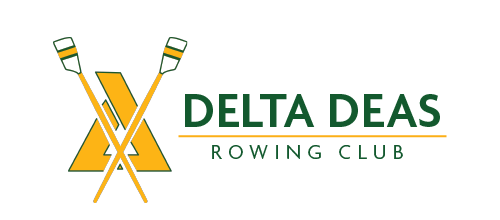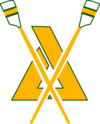“I’m sorry, what did you say?”
Equipment
Boat Components
Deck – The top of the hull, outside the cockpit. In the old days, this was made of stretched canvas.
Fin (Skeg) – A small fin under the hull that helps with stability and straight-line movement.
Footstretcher – The adjustable platform with bolted shoes where rowers secure their feet.
Gunwale (Gunnel) – The upper edge or side of the boat, providing structural support.
Hull – The main body of the boat. The part that floats in the water.
Rigger (Outrigger) – The metal or carbon fiber device that holds the oarlocks, attached to the boat’s side or top.
Bow-mounted rigger – A rigger that mounts behind (afore) of the rower using its oarlocks.
Stern-mounted rigger – A rigger that mounts in front of (abaft) of the rower using its oarlocks.
Seat – The sliding seat that moves along the tracks, allowing rowers to use their legs for power. Avoid getting soap on the wheels at during the end-of-practice clean-up. Soap breaks down the bearings.
Slide (Rail)– The set of runners on which the seat moves.
Oars & Rigging
Blade (Bucket) – The flat part of the oar that enters the water to propel the boat.
Collar – a ring in the middle of the oar that stops it from sliding through the oarlock.
Oar – A long rowing tool with a handle, shaft, and blade designed to be used in an oarlock (unlike a paddle).
Oarlock – The U-shaped piece that holds the oar in place on the rigger, allowing it to pivot.
Height Washers – Small plastic or rubber spacers placed in the oarlock to adjust the height of the oar. The difference between a smooth stroke and feeling like you're fighting your equipment.
Pin – The vertical metal post on the rigger where the oarlock is mounted.
Sleeve – a thin, shaped wrapping in the middle of the oar. It helps control the oar’s rotation in the oarlock, and allows for adjusting collar position.
Toe-Steering – In some boats the rudder is attached by cables to the toe of one rower’s shoes—usually bowseat. When that rower pivots their foot, it turns the rudder. Takes some practice to master.
Rigging – Adjustments to the boat’s setup, including oar length, foot stretcher position, and rigger placement.
Derigging – Removing riggers and other accessories for transport or storage.
A handy guide to the world of rowing terms
Miscellaneous Extras
Pogies – Neoprene or fleece-lined mitts that slip over the oar handle, keeping a rower’s hands warm while allowing for direct grip and control. Essential for cold-weather rowing!
StrokeCoach or SpeedCoach – The brand name of the predominant rowing computer. It mounts in the boat to display stroke rate, speed, and sometimes split times. Basically, like a GPS sports watch for rowers who like numbers (or need proof that they’re going fast).
Seat Pad – A cushion placed on the rowing seat to slightly elevate the rower’s position. Used by those who want less numbness and more happiness on long rows.
In the Boat
Bow – The front of the boat; pointing in the direction of travel. The rower closest to the bow is called the bow seat and is always seat number one. In a boat without coxswain, bow person is responsible for setting the course, steering, and giving commands.
Coxswain (Cox/Coxie) – The person in some boats who steers the boat and gives commands, but does not row. Very rare in sculling.
Port – Because rowers face backwards, port is on the rowers’ right side. If you face the bow, like a coxswain does, port is on the left (like you learned in school).
Sculler – A rower who uses two oars, one in each hand, each about 2.8 m long (9.5 feet).
Starboard – Because rowers face the stern, starboard is on the rowers’ left side. If you face the bow, like a coxswain does, starboard is on the right (like you learned in school).
Stroke Seat – The rower who sits closest to the stern and sets the rhythm for the boat. They have the highest seat number.
Sweep Rower – A rower who uses only one oar, about 3.5 m long (12 feet).
Buoy – A floating marker used to designate race lanes, hazards, or boundaries on the water. Hitting one isn’t ideal, but at least it’s better than hitting a dock.
Deadhead/Dolphin – a submerged log, stuck in the riverbed, usually at a precarious angle. AVOID AT ALL COSTS!!
Common Rowing Calls
"Back it Down" – Rowing in reverse to move the boat backward.
"Back on Port/Star" – Rowing in reverse on the specified side to turn the boat around that oar.
"Hands On" – Command to pick up or carry the boat.
"Heads" – A warning to alert people of a boat being carried overhead.
"Hold on Port/Star" – Holding water only on one side to help with steering or stopping.
"Hold Water" – Stopping the boat by placing the blades square in the water.
"Let it Run" / "Easy" – Stopping the stroke and letting the boat glide. When carrying a boat on land, "Let it run" means to stop moving.
"Power 10" – A call for ten strokes at maximum effort.
"Pressure/Power on Port/Star" – Increasing effort on the specified side, to help with steering.
"Ready all… row" – The command to start rowing. The pause in between is essential, to allow for someone to say they are not ready.
“Roll Towards/Away” – A call to indicate which direction to roll the boat from overhead, either onto stretchers, or into the water.
“Split from Bow” – A call to move the boat from overhead onto the crew’s shoulders. Bowseat will select their preferred shoulder, and rest of crew will split in alternating fashion down to Strokeseat.
“Up to Waists, ready… up” – A call to lift the boat up to waist height. The pause in between is essential, to allow for someone to say they are not ready.
“Up and Overhead, ready…up” – A call to lift the boat from waist height up and overhead. The pause in between is essential, to allow for someone to say they are not ready.
Rowing Stroke & Movements
Stroke Cycle
Catch – The motion where the rower puts the blade of the oar into the water.
Drive – The phase between the Catch and the Release where the blade is in the water, and the rower pushes with their legs and pulls with their arms
Finish/Release – The part of the stroke where the rower extracts the blade of the oar from the water.
Recovery – The phase between the Release and the Catch where the oars are out of the water, and the rower moves forward, preparing for the next stroke.
Stroke Rate (Rating) – The number of stroke cycles the crew completes in one minute.
Common Rowing Errors
Catching a Crab – When an oar gets stuck in the water, usually due to improper release.
Rushing the Slide – Completing the Recovery too quickly.
Shooting the Slide – When the rower drives their legs, but their oars don’t move. It wastes the power of the legs, which are the core of the stroke.
Blade & Oar Movements
Feathering – Rotating the oar blade parallel to the water during recovery to reduce wind resistance.
Full-Slide – Regular rowing, using the full length of the slides to execute a full stroke
Half-Slide – A shortened stroke position, where the seat only comes halfway forward. Short strokes are sometimes used to start the boat from a standstill.
Hip-Hinge – The hip hinge is the movement of pushing the hips back and inclining the torso forward, maintaining a neutral spine with a slight bend of the knees.
Quarter-Slide – A shortened stroke position where the seat is slightly forward, with knees just beginning to bend.
Quarter Feather – A partial rotation of the oar blade between square and feathered positions.
Square Blade – Holding the oar perpendicular to the water, ready for the catch.
Square-Blading – Rowing with the blade squared at all times, without feathering.
Oar Mechanics: Inboard & Outboard
There’s a colourful poster at the back of the boathouse, which lists the Inboard/Outboard measurements of club oars, along with recommendations on which oar sets pair well with each boat class. For most of our oars (those made by Croker) Pink handles are smallest, Yellow are average, Blue are biggest.
Inboard – The part of the oar from the handle to the outside of the collar. This is based on your spread (sculling) or span (sweeping).
Shorter inboard – Increases leverage and marginally increases stroke length, making the drive feel heavier.
Longer inboard – Decreases leverage and marginally reduces stroke length, making the drive feel lighter.
Outboard – The part of the oar from the oarlock to the blade.
Longer outboard – Increases leverage and efficiency, but makes the stroke feel heavier. Makes it harder to row at higher stroke ratings: like a higher gear on a bicycle.
Shorter outboard – Reduces leverage and efficiency but makes the stroke lighter. Makes it easier to row at higher stroke ratings: like a lower gear on a bicycle.
Gearing – The ratio between inboard and outboard. The right gearing is crucial for racing, enabling the fastest balance between stroke power and stroke rate. Competitive rowers fine-tune it for optimal power and control.
Spread/Span – Span is the distance between the pin and the centreline of a sweep boat. Spread is the distance between the pins in a sculling boat.
Tighter spread/span – Increases the distance the oar blade travels through the water. It makes the drive feel heavier and less stable.
Wider spread/span – Decreases the distance the oar blade travels each the water. It makes the drive feel lighter and more stable.


